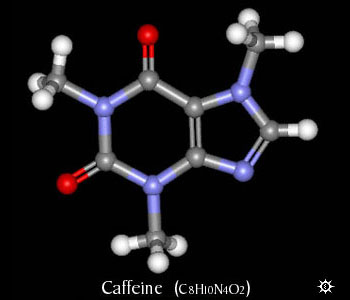by Erowid
| NAME : | Caffeine |
| CHEMICAL NAME : | 3,7-Dihydro-1,3,7-trimethyl-1H-purine-2,6-dione |
| ALTERNATE CHEMICAL NAMES : | 1,3,7-trimethylxanthine; 1,3,7-trimethyl-2,6-dioxopurine; coffeine |
| ALTERNATE CHEMICAL NAMES : | thein; guaranine; methyltheobromine; No-Doz |
| CHEMICAL FORMULA | C8H10N4O2 |
| MOLECULAR WEIGHT | 194.19 |
| LD50 Dog | 140 mg/kg oral |
| LD50 Rat | 105 mg/kg IV |
| LD Low (Lethal Dose) | Human deaths reported at less than 4 grams oral. |
| From the Merck Index 12th Edition | |
|---|---|
| Mechanism of Action | Adenosine receptor antagonist. Phosphodiesterase inhibition keeps cAMP levels high, but may not be clinically relevant. |
| CAS # | 58-08-2 |

Another 3D Caffeine Molecule Image
Caffeine Material Safety Data Sheet (Univ. of Calif.)
Caffeine Material Safety Data Sheet #2
MERCK INDEX ENTRY
1674. Caffeine. 3,7-Dihydro-1,3,7-trimethyl-IH-purine2,6-dione; 1,3,7-trimethylxanthine; 1,3,7-trimethyl-2,6-di oxopurine; coffeine; thein; guaranine; methyltheobromine; No-Doz. C8H10N4O2; mol wt 194.19. C 49.48%, H 5.19%, N 28.85%, O 16.48%. Occurs in tea, coffee, mate leaves; also in guarana paste and cola nuts: Shuman, U.S. pat. 2,508,545 (1950 to General Foods). Obtained as a by-product from the manuf of caffeine-free coffee: Barch, U.S. pat. 2,817,588 (1957 to Standard Brands); Nutting, U.S. pat. 2,802,739 (1957 to Hill Bros. Coffee); Adler, Earle, U.S. pat. 2,933,395 (1960 to General Foods). Crystal structure: Sutor, Acta Cryst. 11, 453(1958). Synthesis: Fischer, Ach. Ber. 28, 2473, 3135 (1895); Gepner, Kreps, J. Gen. Chem. USSR> 16, 179 (1946); Bredereck et al., Ber. 83, 201 (1950); Crippa, Crippa, Farmaco Ed. Sci 10, 616 (1955); Swidinsky, Baizer, U.S. pats. 2,785,162 and 2,785,163 (1957 to Quinine Chem. Works); Bredereck, Gotsmann, Ber. 95, 1902 (1962). Reversed-phase HPLCstudy: J. W. Weyland et al.. J. Chromatog. 247, 221 (1982). Effect of pregnancy on the pharmacokinetics of caffeine: R. Knutti et al, Arch. Toxicol. 5, Suppl., 187 (1982). Binding of caffeine on benzodiazepine receptors: V. Saano, M. M. Airaksinen, Acta Pharmacol. Toxicol 51, 300 (1982). Disposition of caffeine and its metabolites in man: D. D. Tang-Liu et al., J. Pharmacol. Exp. Ther. 224, 180 (1983). Arrhythmogenic effects in humans: D. J. Dobmeyer et al., N. Engl. J. Med. 308, 814 (1983). Teratogenicity study: P. E .Palm et al., Toxicol. Appl. Pharmacol. 44, 1 (1978). Comprehensive description: M. U. Zubair et al., in Analytical Profiles of Drug Substances vol. 15, K. Florey, Ed. (Academic Press, New York, 1986) pp 71-150.
Hexagonal prisms by sublimation, mp 238°. Sublimes 178°. Fast sublimation is obtained at 160-165° under 1 mm press. at 5 mm distance. d18/4 1.23. pH of 1% soln 6.9. Aq solns of caffeine salts dissociate quickly. Absorption spectrum: Hartley, J. Chem. Sec. 87, 1802 (1905). One gram dissolves in 46 ml water, 5.5 ml water at 80°, 1.5 ml boiling water, 66 ml alcohol, 22 ml alcohol at 60', 50 ml acetone, 5.5 ml chloroform, 530 ml ether, 100 ml benzene, 22 ml boiling benzene. Freely sol in pyrrole; in tetrahydrofuran contg about 4% water; also sol in ethyl acetate; slightly in petr ether. Soly in water is increased by alkali benzoates, cinnamates, citrates or salicylates. LD50 orally in mice, hamsters, rats, rabbits(mg/kg): 127, 230, 355, 246 (males); 137, 249, 247, 224 (females) (Palm).
Monohydrate, felted needles, contg 8.5% H2 Efflorescent in air; complete dehydration takes place at 80°.
Hydrochloride dihydrate, C8H11C1N402.2H20, crystals, dec 80-100° with loss of water and HCI. Sol in water and in alcohol with dec.
Mixture with citric acid, citrated caffeine, "caffeine citrate" White, crystalline powder; acid reaction. Sol in about 4 parts warm water. THERAP CAT: CNS stimulant.
THERAP CAT(VET): Has been used as a cardiac and respiratory stimulant and as a diuretic.


